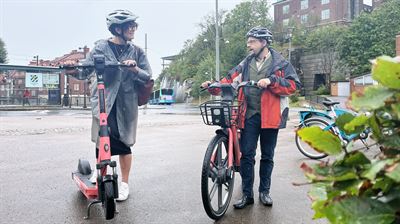- cross-posted to:
- [email protected]
- cross-posted to:
- [email protected]
While our analysis has some limitations and cannot be considered conclusive evidence,
I got curious because the article doesn’t elaborate at all about why that might be, so I read the study, and the study itself says it’s not conclusive. Interesting, sure, but not useful until someone can say exactly why it might be.
Yes the headline is exaggerating the evidence presented in the article - (I’m shocked /s).
I think the authors are confident that the observed crash rate seems to be higher for eBikes . . . but that’s not enough to say which is more dangerous.
I’d think rider attitudes will be one of the main things here - take a negligent or reckless eBiker and put them on an eScooter and I’m pretty sure they’ll find a way to crash it. It’s not obvious to me that they used trip average speed as a proxy for this - I think they should at least have tested if their ratios were the similar when comparing fast with fast and slow with slow - that’d have been easy enough and they probably have the sample size to do that.
They mention high-res GPS data so they could maybe have done a better “driving characteristics” thing - using acceleration and braking data as a proxy for riders who are either bad at reading the road - or are impatient. That might be where they’d need more data, as they’d probably need to establish a “normal” profile for each route - to benchmark the extremes of behaviour.
I guess that’d have taken a lot longer and the funding only goes so far. Interesting dataset they have for sure - maybe they’ll do some more papers on it in future.
From the study:
Although, our findings suggest that e-scooterists may be safer than e-cyclists in urban environments, we only considered crashes involving injured riders using a shared system in a few European city centers in one year. We also assumed that underreporting—an important and well-documented issue especially for micromobility—affects e-scootering and e-cycling equally. Furthermore, the relatively small number of e-cyclist injuries in some of the studied cities (and the absence of reported e-bicycle injuries in two cities) highlights the limitation of the dataset and introduces a degree of uncertainty into the injury rate comparisons. We did not consider whether post-crash consequences and injuries may be more severe on an e-bicycle (where the rider seats higher and dismounting may be harder) than on an e-scooter. It is important to acknowledge that injury data were self-reported by users. However, in the context of this study, where users had no clear incentive to misrepresent injuries, we believe the potential for misreporting is limited. Finally, we assumed the two customer populations to be equivalent. Therefore, while our study is enough to challenge the current scientific literature portraying e-scootering as riskier than cycling, our study does not provide conclusive evidence that one vehicle is safer than the other.
Yes.
If this is in response to “but not useful until someone can say exactly why it might be.”, I did not mean why the study says this, but why either vehicle might be safer over another, which the study admits it can’t do conclusively.
Interesting study. I’m no statiscian but the number of ebike crashes vs escooter crashes anaylzed is wildly different - 35 vs 686. The article says it’s still statistically significant, but I can’t help feel weird about comparing 3 ebike crashes and 156 escooter crashes in Liverpool.
Judging by their stats they must have had data on 150,000-200,000 e bike trips overall. So if you treat each trip as an relevant event for determining the crash rate - then I think it’s a decent enough sample size of eBike trips. It’s just they had heck of a lot more of eScooter data.
The main biassed I’d think are around the rental companies they got data from, and the customer populations. And that they have basically only 7 cities.
but the findings were remarkably consistent over 3 measures of exposure and within each city except Dusseldorf (not enough ebikers to have any crashes).
A couple of the p-values were over 5% or 10% , so some were weaker when narrowing down to an city or just one of the exposure measures - but still a fairly consistent pattern.
Press x to doubt
E-scooters are bigger and faster, and heavier.
And cars even more.
Than e-bikes? Are you mixing up kick-scooter-style e-scooters that people use while standing on them with sit-down vespa-style scooters?
They are talking about the stand-up version, which are smaller, slower and lighter than e-bikes.




